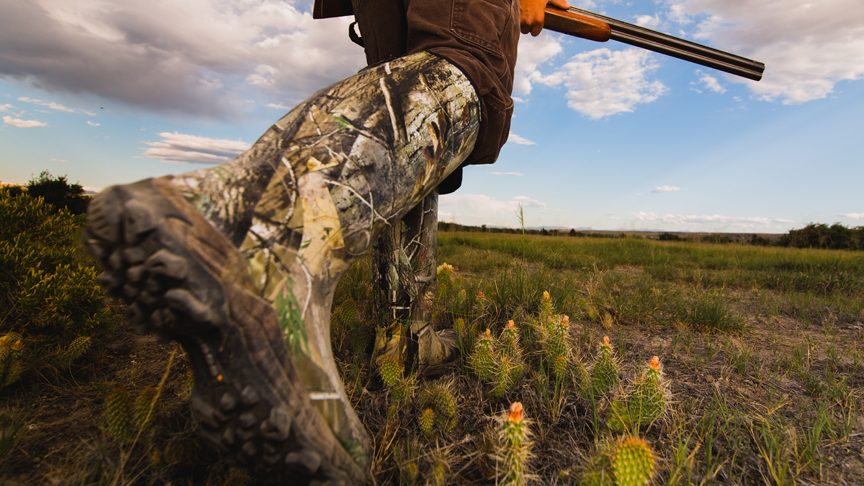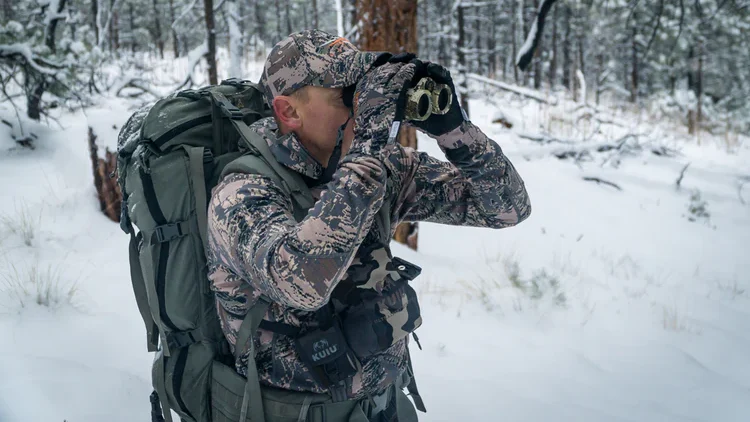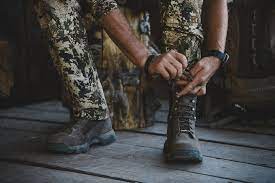Let’s take a moment to recognize boots’ crucial role in your backcountry experience. Your feet are where the rubber meets the road—or, more accurately, where your boots meet rocky mountain trails, muddy ravines, or snowy ridges.
Regardless of your fitness level, the sophistication of your gear, or the sharpness of your hunting instincts, your entire adventure is at risk if your footwear fails.
So, how do you go about selecting the best hunting boots?
Some factors determine a boot’s insulation, stiffness, and height, which are critical for finding comfortable-fitting boots that enable hunters to cover more ground and endure longer journeys.
We will guide you through answering the essential questions about terrain, season, and Weight, demonstrating their impact, and providing valuable pro tips.
So, laceup and prepare to take a significant step toward hunting success—choosing the perfect hunting boots.
3 Questions When Choosing Hunting Boots
Selecting the ideal pair of hunting boots can be as demanding as the hunt itself. The experts at Schnee’s aid customers in unraveling this complexity every day by posing three fundamental yet straightforward questions:
- Where are you hunting?
- When are you hunting?
- What’s your Weight combined with the Weight of your Pack?
Where are you hunting?
“Where are you hunting?” is akin to peeling an onion, with more minor questions embedded within it. To approach this question effectively, let’s break it down into smaller components for you to consider, including:
- Terrain
- Vegetation and Water
- Altitude or Elevation
1. Dissecting the Terrain
Hunting grounds vary widely, encompassing terrains that range from relatively mild to dangerously unpredictable, much like a teenager’s mood. Each terrain demands specific hunting boots tailored to its unique features.
Whether navigating a dry, arid environment or tackling mountainous landscapes, choosing the right boot is essential for braving the elements. It’s akin to selecting the precise tool from a Swiss Army knife, each designed for a specific purpose.
In rocky terrains resembling a meteor shower, opt for boots that breathe well, are lightweight, and can withstand sharp rocks.
On steep slopes, prioritize a boot with excellent ankle support and a grip that rivals a vice for stability.
Choosing hunting boots becomes less of a personal preference and more of a strategic decision.
Let’s delve into specific considerations for familiar terrains you might encounter:
Rough and Uneven: For optimal traction and stability on rough and uneven terrain, prioritize boots with robust ankle support and aggressive soles. These features make it easier to maintain a solid footing but also increase the risk of ankle sprains.
Wet and Muddy: In addition to waterproofing, opt for taller boots in wet or muddy terrain. Keeping dry and comfortable is paramount in such environments.
Flat or Worn: Lighter and more flexible boots work well for flatter or semi-well-trodden areas. They provide a balance of protection and comfort, akin to a second skin rather than heavy armor.
Choosing the right boot tailored to your hunting terrain is akin to hitting the bullseye in darts—it is a critical first step in conquering the wilderness and ensuring a successful hunting expedition.
2. Handling Water and Vegetation
Water and vegetation act like the in-laws to the terrain—sometimes making things more accessible, and other times, adding an extra layer of complexity. When hunting around bodies of water or traversing terrain that requires frequent water crossings, prioritizing waterproof or water-resistant boots is crucial.

While water protection is often assumed when purchasing hunting boots, its importance cannot be overstated, especially during late-season hunts where snowy conditions are likely. Moisture entering your boots can quickly lead to cold feet.
Here’s a quick Public Service Announcement (PSA) for those unsure about the difference between waterproof and water-resistant:
What’s The Difference Between Waterproof and Water-Resistant?
Waterproof: Surfaces that completely repel water or fluids.
Water-Resistant: Surfaces that may repel small volumes of fluids, such as splashes. However, larger volumes or prolonged exposure may compromise the protection. Water-resistant items are generally not suitable for full submersion.
These distinctions, though subtle, have profound effects in the field, particularly for hunters. When shopping for hunting boots, it’s essential to check whether they are labeled as waterproof or water-resistant.
Boots claiming to be waterproof can keep water out completely, regardless of volume or exposure. On the other hand, water-resistant boots may repel some water, but not to the same extent as waterproof boots. They typically have coatings to help resist water and can handle smaller volumes, such as splashes, mud, or light rain.
For vegetation, opt for boots that offer ample protection against pricks and scratches in dense areas. Striking a balance between foot comfort and wilderness resilience is critical. However, this balance might lead to deconstruction during your hike.
What’s the Altitude or Elevation?
Altitude and elevation introduce an intriguing dimension to the hunting equation. As you ascend, conditions become more challenging—terrain becomes unpredictable, temperatures drop, and the risk of injuries increases.
Your boots must rise to the challenge. Seek boots with excellent insulation for colder temperatures and sturdy ankle support to prevent injuries. Consider these boots, the Sherpa to your Everest, designed to help you conquer heights and return safely.
Breaking down the question ‘Where are you hunting?’
into key components—terrain, water and vegetation, altitude or elevation—provides a clearer understanding of what you’re dealing with.
Knowing your hunting ground is akin to studying for an exam; the more you comprehend, the better you face it head-on. Your boots serve as your secret weapon, a silent companion standing with you through the trials of the wild. Choosing the proper boots can make all the difference.
When Are You Hunting?
The timing of your plunge into the wild matters significantly. Seasonal variations extend beyond picturesque calendar images; they influence weather, climate, and terrain, shaping the boots that faithfully carry you through your journey.
Summer Hunts in Humid Locations:
For summer hunts in humid locations, prioritize boots with breathability and moisture-wicking capabilities. These features help keep your feet cool and dry, which is crucial for navigating humid conditions.
Winter Expeditions:
Winter demands heavier insulation to protect against the cold. Ensuring your boots provide adequate insulation enables your body to focus on warming other areas, such as hands, face, and head. Waterproofing is crucial in snowy conditions to prevent frostbite and blister proneness.
Spring and Autumn Adventures:
For unpredictable spring and autumn adventures, opt for boots with moderate insulation and solid waterproofing. These boots should handle the varied challenges of backcountry hunting during these transitional seasons.
Cold and Snowy Weather:

Boots with good insulation and water protection are essential in cold and snowy weather. Proper insulation keeps your feet warm and allows your body to concentrate on warming other parts. Waterproofing is critical to prevent issues like frostbite and blister formation.
Warm and Humid Conditions:
Choose boots with light insulation and excellent ventilation for hunts in warm, hot locations. Ventilation helps dissipate heat, keeping your feet cool and dry. Overheated feet are prone to excessive sweating, leading to discomfort over extended periods and fostering conditions for blisters and fungal growth.
Temperature and Weather Conditions
Average temperatures during your hunting period are not trivial details; they are vital factors determining your boot’s best friend – insulation. On frosty days, boots with thermal liners become saviors, while on hotter days, breathability triumphs, turning your boots into personal air conditioners.
A common mistake hunters make with boots is assuming they always need warm boots for cold days and more than insulated boots for hot days.
While there is some truth to this, the primary goal is to achieve thermal regulation where breathability is crucial.
Comfort is the ultimate aim, transcending the binary of being hot or cold. Your boots should flex along with the natural changes in your body temperature during a hike.
Consider Weather Conditions
Hunting in the rain or navigating a sudden snowfall requires the proper boots equipped with waterproofing, moisture-wicking capabilities, and slip resistance.
Choosing such boots transforms your hunting experience from a survival task to an enjoyable journey. When preparing for a hunting spree, packing the weather forecast and your gear is essential.
Your Weight + Pack Weight?
When embarking on a backcountry hunting trip, your boots don’t just support your body weight; they bear the additional load of your Pack.
Whether your Pack starts at 50 lbs and grows with a successful hunt, the added Weight significantly impacts the stress your boots undergo.
Even without firing a single arrow or bullet, the force your feet and boots bear while walking or hiking surpasses your body weight. This force becomes magnified when ascending a steep incline with a hefty pack, placing extra strain on your boots, particularly affecting the soles and upper construction.
Sturdier and more durable boots are essential for heavier individuals or those carrying substantial packs.
The midsole and outsole should provide excellent support. Your boots act as a reliable bridge over challenging terrain, enduring both your Weight and the added stress of the journey.
Comfort, however, remains paramount. Backcountry hunting is often long and strenuous, and uncomfortable boots can transform an adventure into a struggle. Opt for boots with ample cushioning to ease your feet on challenging terrain. While lightweight boots may feel more comfortable initially, they may wear out quickly under heavy loads.
Factors to look in for Hunting Boots
Most hunting boot designs fall into two broad categories.
Rubber Boots
- Intended for use in sloppy conditions like marshes, swamps, and creeks.
- 100% watertight, making them ideal for waterfowl hunting.
- Scent-free, preventing odor absorption and aiding in avoiding detection by deer.
- Suitable for early-season deer hunting.
Field Boots
- Combine features for versatility in various hunting scenarios.
- Made with full-grain leather or synthetic materials like nylon, polyester, neoprene, and synthetic leather.
- Natural leather boots are durable and mold to the feet over time but tend to be heavier.
- Synthetic boots are more affordable, breathable, and suitable for lighter-duty applications.
Stiffness
- Choose boot stiffness based on the terrain of your hunting area.
- Stiffer boots suit complex terrains, while flexible boots work well in flat country.
Waterproofing and Breathability
- Waterproof boots are suitable for damp environments but may trap sweat, leading to discomfort.
- Consider breathability, especially for high-output hunts in warm conditions.
Insulation
- Choose insulation based on weather and activity level.
- 0-200 grams for early-season or spring hunting, 400-800 grams for mid or late-season, and 1,000 grams and higher for ice-cold weather.
- Use warm socks with lightly insulated boots for versatility.
- Example: Vary insulation based on the specific hunting scenario.
Fit
- Proper sizing is crucial for comfort.
- Try your hunting boots with your preferred socks to ensure comfort during the hunt.
- Boots should fit snugly.
- Consistently use the same sock-boot system for comfort.
Breaking-In
- All boots, especially leather ones, need time to break in.
- Avoid testing brand-new boots in the field; break them in gradually over dozens of miles.
- The time needed for breaking in depends on the boot design.
- Choosing the right hunting boot involves considering the specific conditions of your hunting environment and prioritizing features based on terrain, weather, and personal preferences.
Final Words
In pursuing a successful hunting expedition, the significance of well-chosen boots cannot be overstated. As the crucial interface between the hunter and diverse terrains, these footwear considerations extend beyond personal preference, evolving into a strategic decision.
Delving into specific considerations for terrain, weather, and personal physique, the article offers a comprehensive roadmap for choosing hunting boots.
Ultimately, understanding the nuanced factors at play ensures that your hunting boots become not just gear but reliable companions in the wild, enhancing the likelihood of a triumphant adventure.

